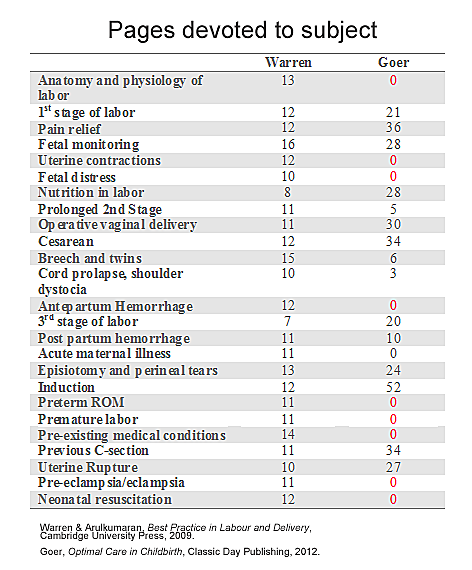Earlier this month I wrote about Henci Goer’s problem with scientific evidence on display in her latest book Optimal Care in Childbirth. Her problem is that the scientific evidence does not support her preferred methods of care. No problem! She simply created excuses as to why she and her supporters can blithely ignore the scientific evidence.
Does it really make sense to ignore scientific evidence when writing about a book about optimal care in childbirth? Not if you foolishly think that optimal care refers to care that is optimal for patients. What a silly mistake! Optimal care in childbirth is care that is optimal for the midwives, childbirth educators and doulas, not for women.
Indeed, the book essentially ignores the large proportion of women who don’t qualify for midwifery care and it ignores a large proportion of essential labor and delivery care. Optimal Care is Childbirth concerns itself with Western women from first world countries who are middle or upper middle class receiving care from (almost exclusively) white, Western middle and upper middle class midwives. And not just any well Western women are worthy of attention, either. Only those who don’t have pre-existing medical conditions, those who don’t have complications of pregnancy, and those who don’t want pharmacological pain relief are worthy of consideration. In other words, if a midwife, childbirth educator or doula can’t make money from you, you are on your own.
Don’t believe me? Try this exercise. Compare Goer’s book with any standard book about care of women in labor. As an example, I chose the textbook Best Practices in Labor and Delivery by Warren and Alkumaran, which concerns the same subject purportedly covered by Goer’s book. Let’s compare the number of pages devoted to various aspects of childbirth care.
A few characteristics of Goer’s book jump out immediately:
- Anatomy and physiology are ignored
- Women who have medical problems are ignored
- Women giving birth before term are ignored
- Fetal distress is ignored
- Pre-eclampsia is ignored
- Neonatal resuscitation is ignored
What are we too make of this? Are women who have complications of pregnancy unworthy of optimal care? I doubt that is what Goer intends. Are doctors always providing optimal care for women who have complications in pregnancy? Perhaps Goer believes this, but I don’t.
No, I believe that the message that Goer is transmitting is she is only interested in what is optimal for midwives, childbirth educators and doulas. Patients who cannot be cared for by midwives are irrelevant.
Another major omission also jumps out. Henci Goer, like most contemporary natural childbirth advocates, has piously expressed dismay over maternal mortality rates. Curiously, she devotes no attention to any of the 5 leading causes of maternal mortality: maternal cardiac disease, hemorrhage, pre-eclampsia/eclampsia, infection and embolism. She only addresses maternal mortality briefly and then only in relation to interventions. In contrast, there are literally dozens of pages devoted to maternal morbidity. That only makes sense if your motivation is tout midwives who boast about reducing morbidity, but often in exchange for increasing mortality.
What jumps out when you consider what is included? The topics that receive the most attention are childbirth interventions. Although the chart doesn’t show it, reading the book demonstrates that the bulk of the material on each intervention is devoted to vilifying it. When scientific evidence exists to minimize the use of a specific intervention, Goer presents it. When scientific evidence supports the use of a specific intervention, Goer presents that, too, and then proceeds to declare that the evidence can be ignored.
For example, the chapter on pain relief includes precious little information on the benefits and effectiveness of epidurals and a lot of material on rare complications. One of the very few mentions of maternal mortality in the entire book is the exceedingly rare incidence of maternal mortality in association with epidurals, though the actual risk of maternal mortality from a labor epidural is less than the chance of being struck by lightning.
Indeed, Goer’s discussion of maternal mortality from epidurals is a paradigmatic example of her entire approach to the issue of childbirth. There is no discussion of the leading causes of maternal mortality because the book is not about saving women’s lives or what is beneficial for them. The book is about lining the pockets of midwives, childbirth educators and doulas, and that’s why it is important to evoke the specter of maternal death only in association with epidurals.
Equally enlightening is the inclusion of homebirth. Goer’s book contains 25 pages on homebirth, a practice that accounts for less than 1% of American births. It makes no sense to devote so much space to a fringe practice unless you focus on who attends homebirths. More than 90% of American homebirths are attended by midwives and most are attended by doulas. No book about what is optimal for midwives and doulas would be complete without it.
Obviously, Goer is entitled to write whatever she wants, but no one should be fooled into thinking that Optimal Care in Childbirth has anything to do with the well being of women or babies. Optimal Care in Childbirth is about what is optimal for midwives, childbirth educators and doulas. What is optimal for mothers and babies is apparently irrelevant.



